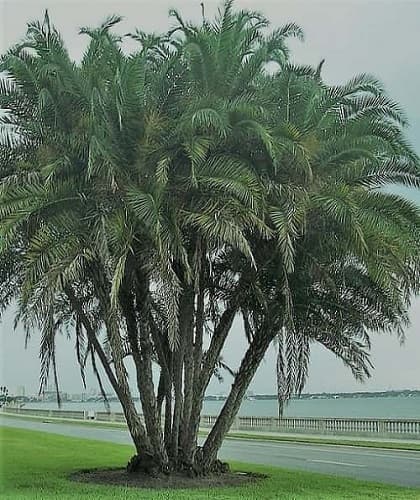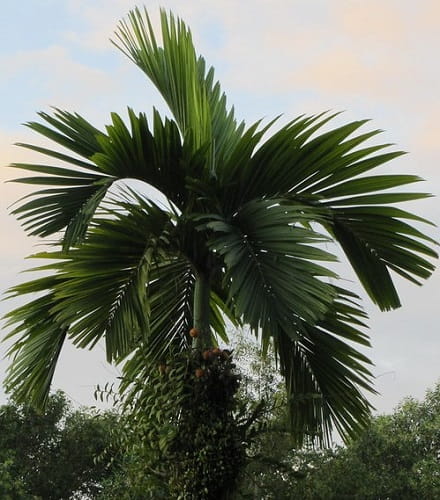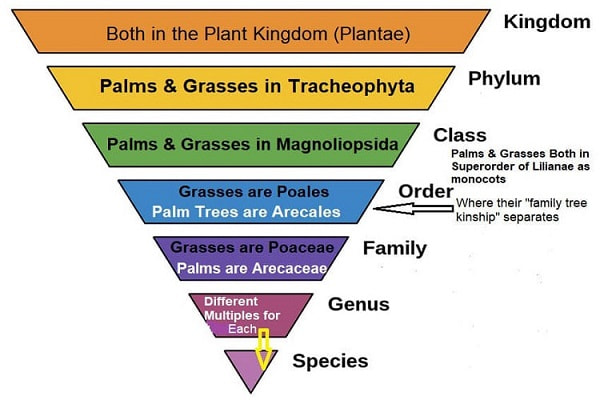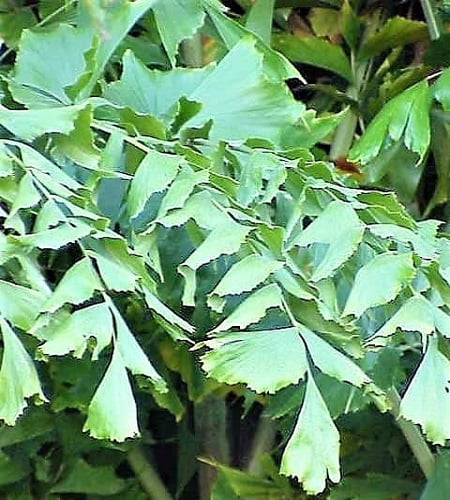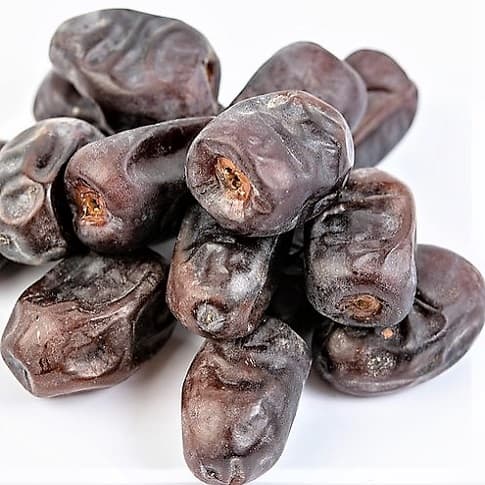- Home
- Palm Physique
Parts of a Palm Tree - Some May Surprise You!
Have you ever thought about a palm's physique?!
Well, palm trees have a "bod" too! The parts of a palm tree make up its structure. For plant and/or palm lovers, that's good to know. To see what a unique plant a palm tree is.
Knowing the parts of a palm tree is also good when doing some research. So we can understand words being used. Many specialized words are in this palm tree world! Getting familiar with them helps us be a part of it!
We'll break it down to basics. Making it more easy-peasy.
Scroll down to learn it all! Or go to specifics...
Feeling overwhelmed by so many palm trees?
You're not alone. We Understand your headaches! At Mission: Palm Trees you'll find clear answers to questions & Step-By-Step Guidance, from real people. With solutions to help. No puzzling shoptalk. No tiring research. So it's easy & fun for you.
Common Words for Parts of a Palm Tree
Basic Words - The Need to Know
Juice up your vocabulary learning years.
Cuz we have some words for you to know. Essential words if you're reading about your favorite palm.
- Or being knowledgeable when talking with landscapers.
- Or wandering through tropical areas of Botanical Gardens.
- Or speaking with other Palm aficionados.
Essential Palm Tree Vocabulary
CLUSTERING:
- For palm trees, it's the type that grow several trunks out from the base.
SOLITARY PALM:
- Palm tree types that have one trunk only.
ENDEMIC:
- Where a Palm Tree Originated, in a limited specific area. Similar words are native or indigenous.
FROND:
- A palm leaf.
INFLORESCENCE:
- Stalk or stem where developing palm tree flowers grow.
INFRUCTESCENCE:
- After fruit develops on the inflorescence, it now has this term.
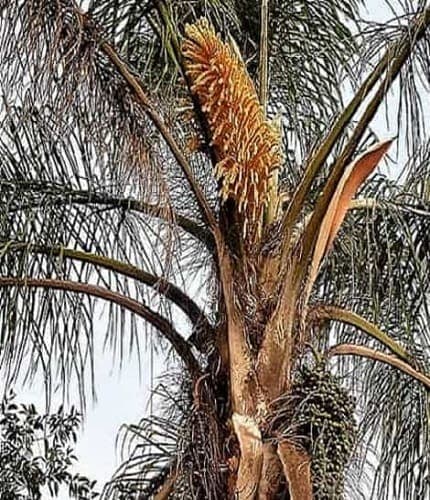 Syagrus romanzoffiana or Queen Palm
Syagrus romanzoffiana or Queen PalmInflorescence Above With Flowers
Infructescence With Fruit Below
Photo: JMK - CC BY-SA 4.0
PALMATE:
- Type of Palm Tree Frond. Leaflets all come out of the stem from a central point.
- This part of a palm tree is also named for looking like a hand's palm & fingers.
- Another descriptive common name is Fan Palm.
PINNATE:
- Type of palm tree frond. Feathery look to it. Leaflets grow out along a center stem.
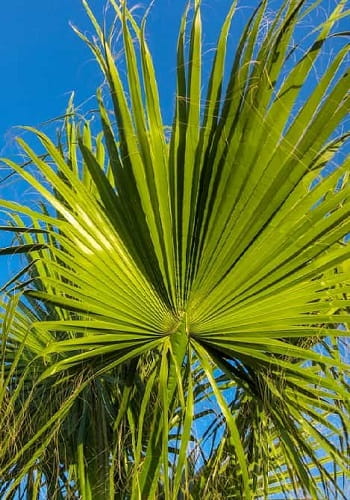 A Palmate Frond
A Palmate FrondPETIOLE
- Stem of the palm frond. Growing from the node (the trunk attachment) of the trunk to where blades (main leaf area) begin.
- The petiole becomes the costa in costapalmate fronds
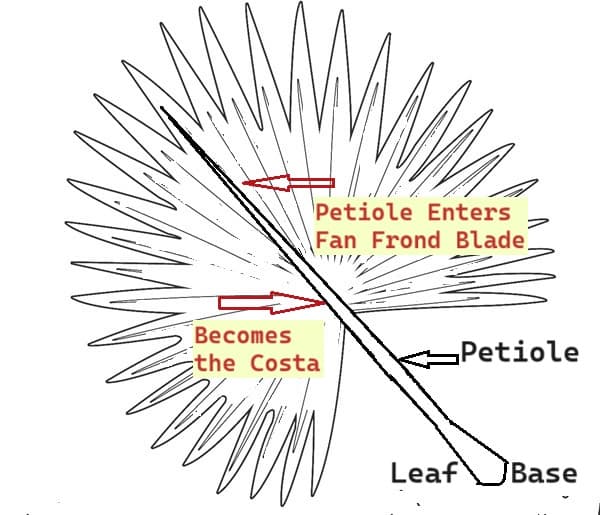
- The petiole becomes the rachis in pinnate fronds.
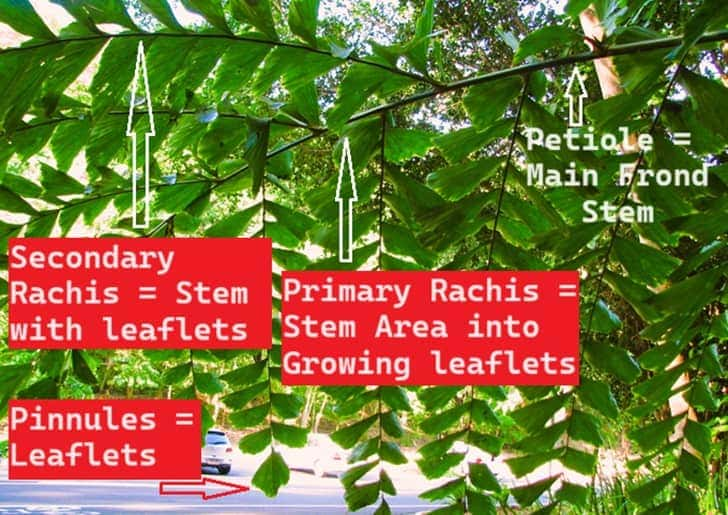
SPINE:
- A sharp prong, you probably figured this one! Growing from fronds, stems, trunks or branches.
- If there aren't any, it's an unarmed palm.
Higher End Palm Vocabulary
You'll hear these less common terms for palm tree parts when doing more serious research.
Good to know when reading about palms. In serious palm tree books or encyclopedic types of palm tree websites.
SPEAR:
- Newest frond starting to grow out.
INDUPLICATE:
- Leaflets or segments folding upward appearing "V" shaped.
REDUPLICATE:
- Leaflets or segments that look like an upside-down "V" or folding downward.
MONOCOT:
- Short for Monocotyledon. Plants that Have a Single Embryonic Sprouting Leaf that comes out of their seed, as opposed to multiples.
- Their flowers have three sections.
- Leaf veins form in lines.
- Their nourishment system is in scattered cell bundles.
NODE:
- The spot where a leaf's petiole attaches to the trunk.
RACHIS:
- Beginning at the end of petioles, continuation of frond stems in pinnate palms.
ANY NOT SEEN HERE
Then each part of a palm tree gets even more specific. So going deeper, you'll see each part has its own sub-terms. More definitions/explanations as we move along.
Newest Palm Article
-
What Is Palm Wine? Definition, Origin, and Cultural Purpose Explained
We answer your question: what is palm wine? How it’s made, and why it’s treasured across Africa, Asia & South America. Learn its taste, and traditional uses.
Palm Trees are Grass?
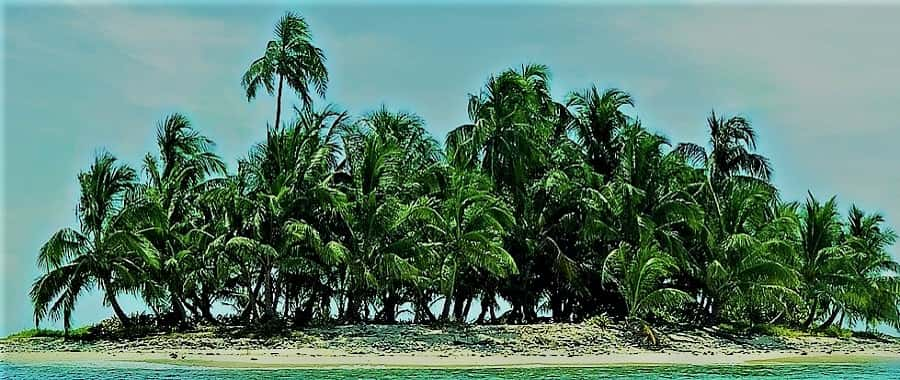 Do You See An Island of Very Tall Grasses Here?
Do You See An Island of Very Tall Grasses Here?PALMS ARE GRASS?
Some ask: are palm trees grass? Does that sound a bit weird? Sort-of, but in a way - not so much!
Palms aren't your typical trees. They have more in common with grass...
- For some parts of palm trees
- How they're put together
- And the way they grow
Not only that, their workings are also similar to corn stalks & rice plants. Much more-so than with a typical tree.
Are Palm Trees Just Tall Grass?
Palm trees are related to grass. How? Taxonomy explains the relationship. Seeing how the plant kingdom is organized shows palms' relationship to grass.
FORMING SCIENTIFIC NAMES
The whole name is called the Binomial. It has two parts. Written in italics, or if need-be, underlined.
- First Part is the Genus. Always capitalized.
- Second comes the species, also called the epithet. It's not capitalized.
- Many also have regular, common names, easy for people to use.
Inside a Palm Tree
INSIDE A PALM TRUNK
A palm tree trunk's "guts" are very different from usual trees, like oaks, pines or maples. Those trees have two internal systems to get food & water where they're needed. Kind of like blood vessels. Palms don't have this kind of network.
Instead there are little separate bundled parts of the palm tree scattered through the trunks and stems.
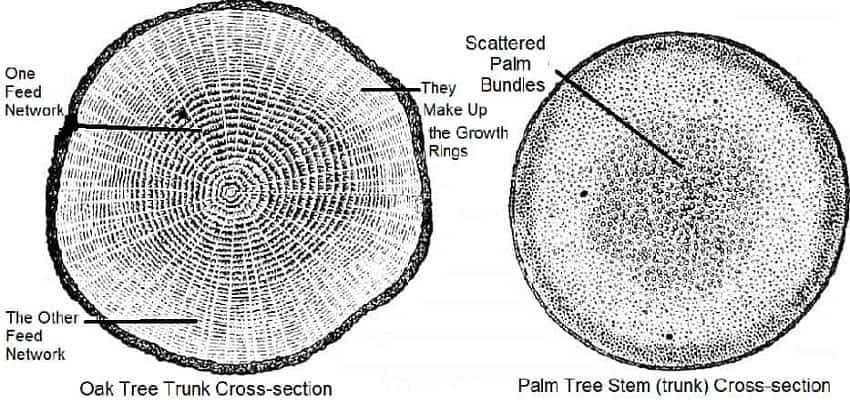 Differing Systemic Nourishment Systems
Differing Systemic Nourishment SystemsHOW PALMS ARE DIFFERENT
Because of this set-up, palms lack some traits:
- There's no secondary growth. Trunk growth doesn't continue expanding all through their life.
- All stems (trunks) stay at the width they grow to when established. Trunks can't normally grow outward any further.
- The original little nourishment packs aren't replaceable. They don't keep multiplying. Once the palm grows to its tallest, no more are supplied.
PALMS DON'T ACCEPT GRAFTING
- Successful life & growth must depend on the trunk's palm heart for its ability to continue on.
- If injuries happen to the mainstem heart (growing point or meristem), it can't be repaired.
- That eventuality is death.
Parts of a Palm Tree Roots
SEED ACTION
A Planted Palm Tree Seed ejects a starter root.
Soon replaced by roots from the newly growing stem. They grow out as wide as they'll ever get. That's their maximum width set point. But they can spread outward widely.
ROOTS BRING FOOD
Root design is different from parts of a palm tree that's from its base & up. The innards have layers which help get food supplies inward & upward. The nourishment bundles have connecting strands through the palm's trunk. Roots can regrow when cut/damaged during transplantation.
Trunk of a Palm Tree
BABY STAGE
A baby palm tree coming up from seed begins with overlapping fronds - making a protective cover over the palm heart. Palms spend the first few years growing to their full width. Before growing further upward.
That first growing step is the palm's most unstable time.
GETS STRONG: GROWING UP
As it grows, an outer hard, thick layer for support forms. Some compare this layer's strength to rebar in concrete.
But not a comparison to bark of a deciduous tree!
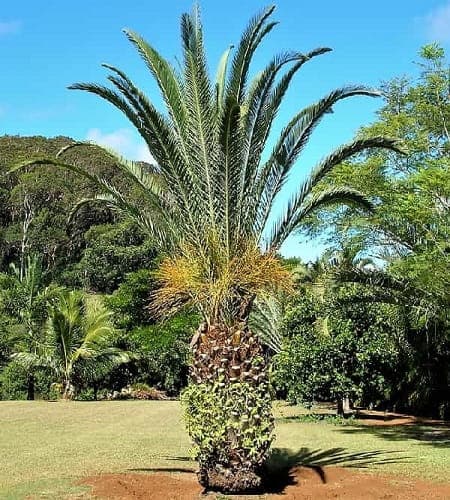 Young Canary Island Date Palm
Young Canary Island Date PalmHas Full Grown Width On Its Trunk
Time To Grow Upward Now!
Photo: Forest & Kim Starr - CC BY 4.0
Styles of Palm Tree Trunks
Trunks (or stems) can be solitary or clustering.
Some in rain forests even grow as vines. Others grow offshoots at the trunk's base, called suckers, which help them spread.
Some shed dead leaves, doing housekeeping on their own! They leave scars which show as circular rings around the trunk. Or they make an interesting surface pattern.
Others hang onto their dead fronds. Just can't let them go!
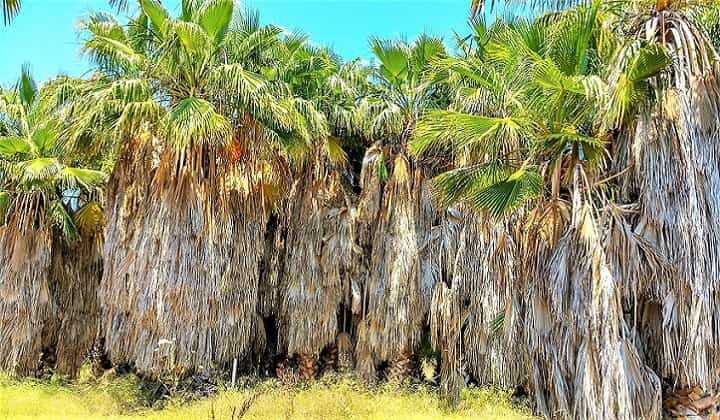 These Palms Just Love Holding Onto All Their Expired Palm Fronds!
These Palms Just Love Holding Onto All Their Expired Palm Fronds!Hoarding Them??
Many have swellings somewhere along the length of the palm trunk. Some have spines.
PALM TRUNK COLORS
Trunk coloring can be gray or brown, less often green.
Palm Tree Fronds
PALM LEAVES
Palm Tree Fronds are the leaves of the palm tree. A noticeable part of a palm tree, for sure! Wouldn't you say?
Helpful for palm tree identification. Plus famed as the largest leaves in the plant kingdom.
PALM FROND TERMS
Here are some terms for Leaf Parts of a Palm tree:
Three Main Frond Parts:
- LEAF BASE - Also called the leaf sheath
- PETIOLE - Connector for the leaf base to the blade. The leaf stem.
- BLADE - All the leaflets or segments attached to the stem, also called lamina.
Frond Vocabulary
Palmate Words:
- SEGMENTS - Portions of the blade, often split at the end
- HASTULA - Small semi-circular ridge where the petiole attaches to the blade
Pinnate Words:
- CROWN SHAFT - Collar bulge of leaf bases circling the trunk (stem)
- RACHIS - Continuation of the leaf stem, where leaflets attach
First Thing to Palm Tree Identification
First thing to do for figuring out which palm tree you're looking at is to see if they're pinnate or palmate.
- Does each palm frond have a feathery look, with multiple leaflets off the rachis? It's pinnate.
- Are the fronds reduplicate? Helps to confirm pinnate.
- Or does each frond have segments coming out of the petiole? Which is then attached to the trunk? It's palmate.
- Are the fronds induplicate? Helps in confirmation.
SUBDIVISIONS
Palmates have a subdivision.
- Costapalmate - Has fronds with a rib-like outgrowth of the petiole (remember: the stem) into the leaf blade.
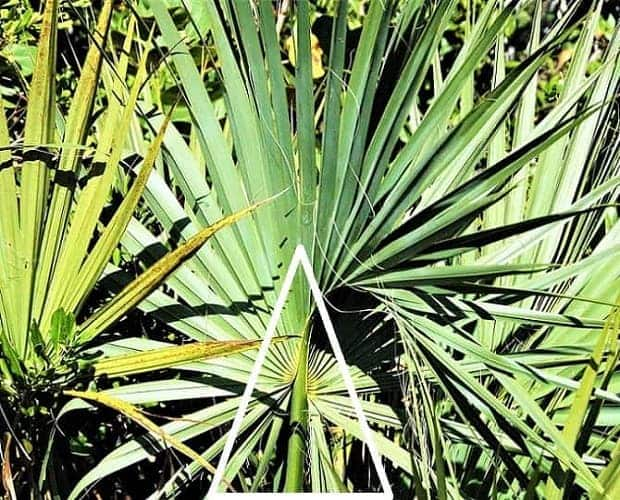 Triangle Outlines the Ribby Growth from the Petiole into the Frond
Triangle Outlines the Ribby Growth from the Petiole into the FrondMeaning this Sabal Palmetto is a Costapalmate
James St John @Flickr - CC BY 4.0
Pinnates Have Subdivisions
- Pinnately Compound - Has rows of leaflets on the rachis. No matter how many or few, or the arrangement.
- Bipinnate or Bipinnately Compound - A secondary rachis with the leaflets extends from the main rachis.
- Only found in Caryoteae, a "tribe" in the subfamily Arecoideae.
Palm Tree Flowers
Each palm tree flower isn't very noticeable, as they're tiny.
What makes them flashy is their altogether appearance on long flower stems - the inflorescence.
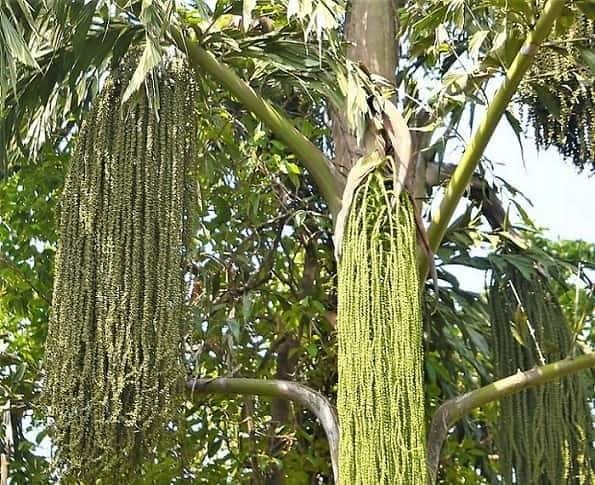 Caryota urens inflourescence Produces Fruits With Unpalatable Juice
Caryota urens inflourescence Produces Fruits With Unpalatable JuiceBut the Sap From Its Trunk is Another Story Altogether!
Photo: Dinesh Valke @Flickr - CC BY-SA 4.0
INFLORESCENCE STRUCTURE
Most inflorescences have multiple branches, and are long. Though not always.
- Starts with a specialized bract (modified leaf) called a spadix or spathe.
- Wood-like, it's canoe-shaped, covering the growing inflorescence.
- Finally the inflorescence outgrows the spathe covering.
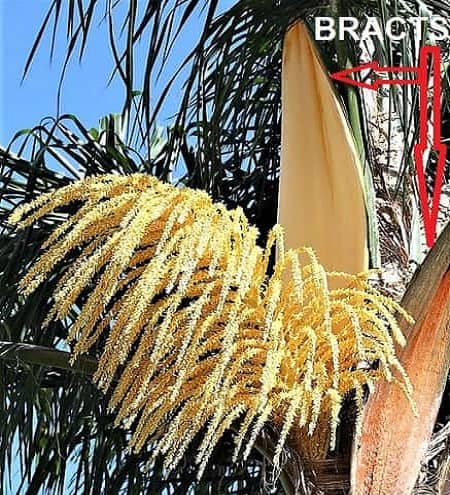 Spathe - The Special Bract for Inflorescence
Spathe - The Special Bract for InflorescenceWHERE/HOW THEY GROW
- Inflorescences grow from below the crownshaft.
- If no crownshaft, they grow amidst the palm fronds.
- A few have unique features:
- Growing from stem tips, and only flower once
- Some species' bracts remain through fruiting
Sexuality of Palm Tree Flowers
PALM LOVE-LIFE 😮
Do palms have a love-life?! It's their own version. It may be as complicated, or even more-so than the human version!!
Most palm trees get insects involved in their sex relations. Helping to pollinate flowers. Aiding transfer of male stamen's pollen to the female's stigma at the pistil.
PALM GENDER IDENTITIES
What types of palm flower sex identities are there?
Monoecious or Pistillate - One palm plant with flowers of either arrangement:
- Bisexual Flowers - These have both male & female flower-type reproductive "organs." Botanically they're termed "perfect."
- Cohabiting Genders - These have male & female flowers intermingling alongside on the same inflorescence. Sometimes they grow separately by gender, each on an inflorescence on the same palm tree.
Strictly Separating - Termed dioecious.
- These flowers stay to their own palm tree according to gender. Some species' trees are male, and some are female.
MORE ON MONOECIOUS VS. DIOECIOUS>
Palm Fruits & Identification
The so-small flowers generate much larger Palm Fruits. Many are brightly colored.
Some are so large they're renowned parts of the palm tree world. Like the double coconut, containing the largest plant seed on earth!
Palm fruits are often called nuts (think of the coconut). Others are types of berries. Occasionally some call them Palm Tree Pods.
Most are classed as drupes. Meaning there's one seed. When ripe, the skin doesn't split to release it. Think of a date fruit.
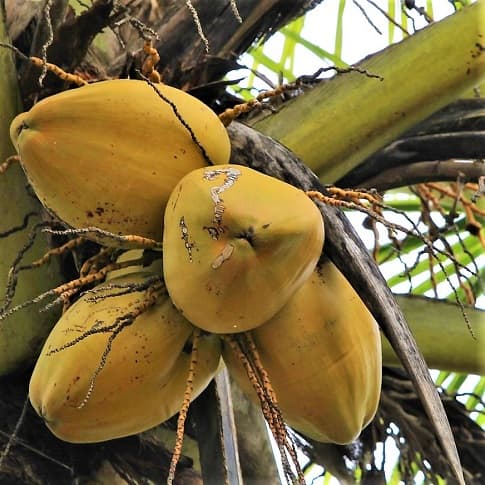 Coconuts Growing on the Cocos nucifera Palm
Coconuts Growing on the Cocos nucifera PalmPALM FRUIT IDENTIFICATION
Palm fruit skin is usually smooth. But some can be hairy, prickly or covered with scales or wart-like bumps.
Identifying palm tree fruit helps with identifying the palm species. But fruit is not always there, so it's best to begin with evaluating the palm tree parts. And that begins by knowing the basic parts of palm trees.
Palm tree identification knowledge takes some time. But you certainly can start with the essentials - knowing how to differentiate the parts of a palm tree!
Takeaways for Parts of a Palm Tree
Did this help you get the lingo for parts of a palm tree? We hope so. There are even more detailed parts of palms, including lots more technical language.
Knowing the most important parts, along with associated terms helps everyone get along better in the palm world!
